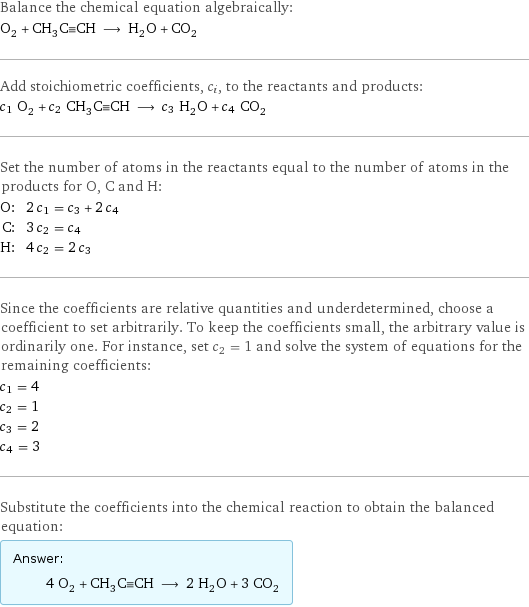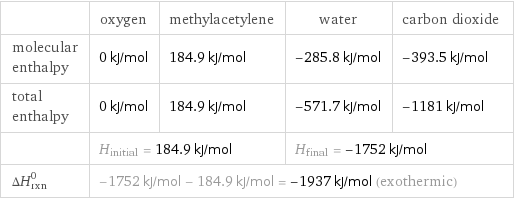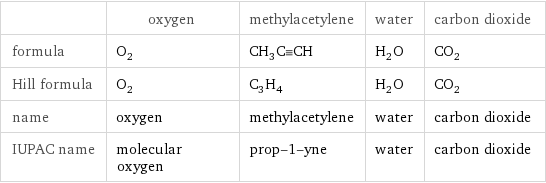Input interpretation

O_2 oxygen + CH_3C congruent CH methylacetylene ⟶ H_2O water + CO_2 carbon dioxide
Balanced equation

Balance the chemical equation algebraically: O_2 + CH_3C congruent CH ⟶ H_2O + CO_2 Add stoichiometric coefficients, c_i, to the reactants and products: c_1 O_2 + c_2 CH_3C congruent CH ⟶ c_3 H_2O + c_4 CO_2 Set the number of atoms in the reactants equal to the number of atoms in the products for O, C and H: O: | 2 c_1 = c_3 + 2 c_4 C: | 3 c_2 = c_4 H: | 4 c_2 = 2 c_3 Since the coefficients are relative quantities and underdetermined, choose a coefficient to set arbitrarily. To keep the coefficients small, the arbitrary value is ordinarily one. For instance, set c_2 = 1 and solve the system of equations for the remaining coefficients: c_1 = 4 c_2 = 1 c_3 = 2 c_4 = 3 Substitute the coefficients into the chemical reaction to obtain the balanced equation: Answer: | | 4 O_2 + CH_3C congruent CH ⟶ 2 H_2O + 3 CO_2
Structures

+ ⟶ +
Names

oxygen + methylacetylene ⟶ water + carbon dioxide
Reaction thermodynamics
Enthalpy

| oxygen | methylacetylene | water | carbon dioxide molecular enthalpy | 0 kJ/mol | 184.9 kJ/mol | -285.8 kJ/mol | -393.5 kJ/mol total enthalpy | 0 kJ/mol | 184.9 kJ/mol | -571.7 kJ/mol | -1181 kJ/mol | H_initial = 184.9 kJ/mol | | H_final = -1752 kJ/mol | ΔH_rxn^0 | -1752 kJ/mol - 184.9 kJ/mol = -1937 kJ/mol (exothermic) | | |
Equilibrium constant
![Construct the equilibrium constant, K, expression for: O_2 + CH_3C congruent CH ⟶ H_2O + CO_2 Plan: • Balance the chemical equation. • Determine the stoichiometric numbers. • Assemble the activity expression for each chemical species. • Use the activity expressions to build the equilibrium constant expression. Write the balanced chemical equation: 4 O_2 + CH_3C congruent CH ⟶ 2 H_2O + 3 CO_2 Assign stoichiometric numbers, ν_i, using the stoichiometric coefficients, c_i, from the balanced chemical equation in the following manner: ν_i = -c_i for reactants and ν_i = c_i for products: chemical species | c_i | ν_i O_2 | 4 | -4 CH_3C congruent CH | 1 | -1 H_2O | 2 | 2 CO_2 | 3 | 3 Assemble the activity expressions accounting for the state of matter and ν_i: chemical species | c_i | ν_i | activity expression O_2 | 4 | -4 | ([O2])^(-4) CH_3C congruent CH | 1 | -1 | ([CH3C congruent CH])^(-1) H_2O | 2 | 2 | ([H2O])^2 CO_2 | 3 | 3 | ([CO2])^3 The equilibrium constant symbol in the concentration basis is: K_c Mulitply the activity expressions to arrive at the K_c expression: Answer: | | K_c = ([O2])^(-4) ([CH3C congruent CH])^(-1) ([H2O])^2 ([CO2])^3 = (([H2O])^2 ([CO2])^3)/(([O2])^4 [CH3C congruent CH])](../image_source/acf65d8291e62109304b776a87eef225.png)
Construct the equilibrium constant, K, expression for: O_2 + CH_3C congruent CH ⟶ H_2O + CO_2 Plan: • Balance the chemical equation. • Determine the stoichiometric numbers. • Assemble the activity expression for each chemical species. • Use the activity expressions to build the equilibrium constant expression. Write the balanced chemical equation: 4 O_2 + CH_3C congruent CH ⟶ 2 H_2O + 3 CO_2 Assign stoichiometric numbers, ν_i, using the stoichiometric coefficients, c_i, from the balanced chemical equation in the following manner: ν_i = -c_i for reactants and ν_i = c_i for products: chemical species | c_i | ν_i O_2 | 4 | -4 CH_3C congruent CH | 1 | -1 H_2O | 2 | 2 CO_2 | 3 | 3 Assemble the activity expressions accounting for the state of matter and ν_i: chemical species | c_i | ν_i | activity expression O_2 | 4 | -4 | ([O2])^(-4) CH_3C congruent CH | 1 | -1 | ([CH3C congruent CH])^(-1) H_2O | 2 | 2 | ([H2O])^2 CO_2 | 3 | 3 | ([CO2])^3 The equilibrium constant symbol in the concentration basis is: K_c Mulitply the activity expressions to arrive at the K_c expression: Answer: | | K_c = ([O2])^(-4) ([CH3C congruent CH])^(-1) ([H2O])^2 ([CO2])^3 = (([H2O])^2 ([CO2])^3)/(([O2])^4 [CH3C congruent CH])
Rate of reaction
![Construct the rate of reaction expression for: O_2 + CH_3C congruent CH ⟶ H_2O + CO_2 Plan: • Balance the chemical equation. • Determine the stoichiometric numbers. • Assemble the rate term for each chemical species. • Write the rate of reaction expression. Write the balanced chemical equation: 4 O_2 + CH_3C congruent CH ⟶ 2 H_2O + 3 CO_2 Assign stoichiometric numbers, ν_i, using the stoichiometric coefficients, c_i, from the balanced chemical equation in the following manner: ν_i = -c_i for reactants and ν_i = c_i for products: chemical species | c_i | ν_i O_2 | 4 | -4 CH_3C congruent CH | 1 | -1 H_2O | 2 | 2 CO_2 | 3 | 3 The rate term for each chemical species, B_i, is 1/ν_i(Δ[B_i])/(Δt) where [B_i] is the amount concentration and t is time: chemical species | c_i | ν_i | rate term O_2 | 4 | -4 | -1/4 (Δ[O2])/(Δt) CH_3C congruent CH | 1 | -1 | -(Δ[CH3C congruent CH])/(Δt) H_2O | 2 | 2 | 1/2 (Δ[H2O])/(Δt) CO_2 | 3 | 3 | 1/3 (Δ[CO2])/(Δt) (for infinitesimal rate of change, replace Δ with d) Set the rate terms equal to each other to arrive at the rate expression: Answer: | | rate = -1/4 (Δ[O2])/(Δt) = -(Δ[CH3C congruent CH])/(Δt) = 1/2 (Δ[H2O])/(Δt) = 1/3 (Δ[CO2])/(Δt) (assuming constant volume and no accumulation of intermediates or side products)](../image_source/42d55e640890403d218d46e93fc0780f.png)
Construct the rate of reaction expression for: O_2 + CH_3C congruent CH ⟶ H_2O + CO_2 Plan: • Balance the chemical equation. • Determine the stoichiometric numbers. • Assemble the rate term for each chemical species. • Write the rate of reaction expression. Write the balanced chemical equation: 4 O_2 + CH_3C congruent CH ⟶ 2 H_2O + 3 CO_2 Assign stoichiometric numbers, ν_i, using the stoichiometric coefficients, c_i, from the balanced chemical equation in the following manner: ν_i = -c_i for reactants and ν_i = c_i for products: chemical species | c_i | ν_i O_2 | 4 | -4 CH_3C congruent CH | 1 | -1 H_2O | 2 | 2 CO_2 | 3 | 3 The rate term for each chemical species, B_i, is 1/ν_i(Δ[B_i])/(Δt) where [B_i] is the amount concentration and t is time: chemical species | c_i | ν_i | rate term O_2 | 4 | -4 | -1/4 (Δ[O2])/(Δt) CH_3C congruent CH | 1 | -1 | -(Δ[CH3C congruent CH])/(Δt) H_2O | 2 | 2 | 1/2 (Δ[H2O])/(Δt) CO_2 | 3 | 3 | 1/3 (Δ[CO2])/(Δt) (for infinitesimal rate of change, replace Δ with d) Set the rate terms equal to each other to arrive at the rate expression: Answer: | | rate = -1/4 (Δ[O2])/(Δt) = -(Δ[CH3C congruent CH])/(Δt) = 1/2 (Δ[H2O])/(Δt) = 1/3 (Δ[CO2])/(Δt) (assuming constant volume and no accumulation of intermediates or side products)
Chemical names and formulas

| oxygen | methylacetylene | water | carbon dioxide formula | O_2 | CH_3C congruent CH | H_2O | CO_2 Hill formula | O_2 | C_3H_4 | H_2O | CO_2 name | oxygen | methylacetylene | water | carbon dioxide IUPAC name | molecular oxygen | prop-1-yne | water | carbon dioxide